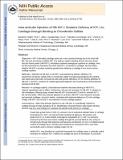Intra-articular Injection of HB-IGF-1 Sustains Delivery of IGF-1 to Cartilage through Binding to Chondroitin Sulfate
Author(s)
Miller, Rachel Elizabeth; Grodzinsky, Alan J.; Cummings, Kiersten; Plaas, Anna H. K.; Cole, Ada A.; Lee, Richard T.; Patwari, Parth; ... Show more Show less
DownloadGrodzinsky_Intra-articular injection.pdf (1.774Mb)
OPEN_ACCESS_POLICY
Open Access Policy
Creative Commons Attribution-Noncommercial-Share Alike
Terms of use
Metadata
Show full item recordAbstract
Objective:
Insulin-like growth factor 1 (IGF-1) stimulates cartilage repair but is not a practical therapy due to its short half-life. We have previously modified IGF-1 by adding a heparin-binding domain and have shown that this fusion protein (HB-IGF-1) stimulates sustained proteoglycan synthesis in cartilage. This study was undertaken to examine the mechanism by which HB-IGF-1 is retained in cartilage and to test whether HB-IGF-1 provides sustained growth factor delivery to cartilage in vivo and to human cartilage explants.
Methods:
Retention of HB-IGF-1 and IGF-1 was analyzed by Western blotting. The necessity of heparan sulfate (HS) or chondroitin sulfate (CS) glycosaminoglycans (GAGs) for binding was tested using enzymatic removal and cells with genetic deficiency of HS. Binding affinities of HB-IGF-1 and IGF-1 proteins for isolated GAGs were examined by surface plasmon resonance and enzyme-linked immunosorbent assay.
Results:
In cartilage explants, chondroitinase treatment decreased binding of HB-IGF-1, whereas heparitinase had no effect. Furthermore, HS was not necessary for HB-IGF-1 retention on cell monolayers. Binding assays showed that HB-IGF-1 bound both CS and HS, whereas IGF-1 did not bind either. After intraarticular injection in rat knees, HB-IGF-1 was retained in articular and meniscal cartilage, but not in tendon, consistent with enhanced delivery to CS-rich cartilage. Finally, HB-IGF-1 was retained in human cartilage explants but IGF-1 was not.
Conclusion:
Our findings indicate that after intraarticular injection in rats, HB-IGF-1 is specifically retained in cartilage through its high abundance of CS. Modification of growth factors with heparin-binding domains may be a new strategy for sustained and specific local delivery to cartilage.
Date issued
2010-11Department
Massachusetts Institute of Technology. Department of Biological EngineeringJournal
Arthritis and Rheumatism
Publisher
Wiley Blackwell
Citation
Miller, Rachel E. et al. “Intraarticular Injection of Heparin-binding Insulin-like Growth Factor 1 Sustains Delivery of Insulin-like Growth Factor 1 to Cartilage Through Binding to Chondroitin Sulfate.” Arthritis & Rheumatism 62.12 (2010): 3686–3694.
Version: Author's final manuscript
ISSN
0004-3591
1529-0131